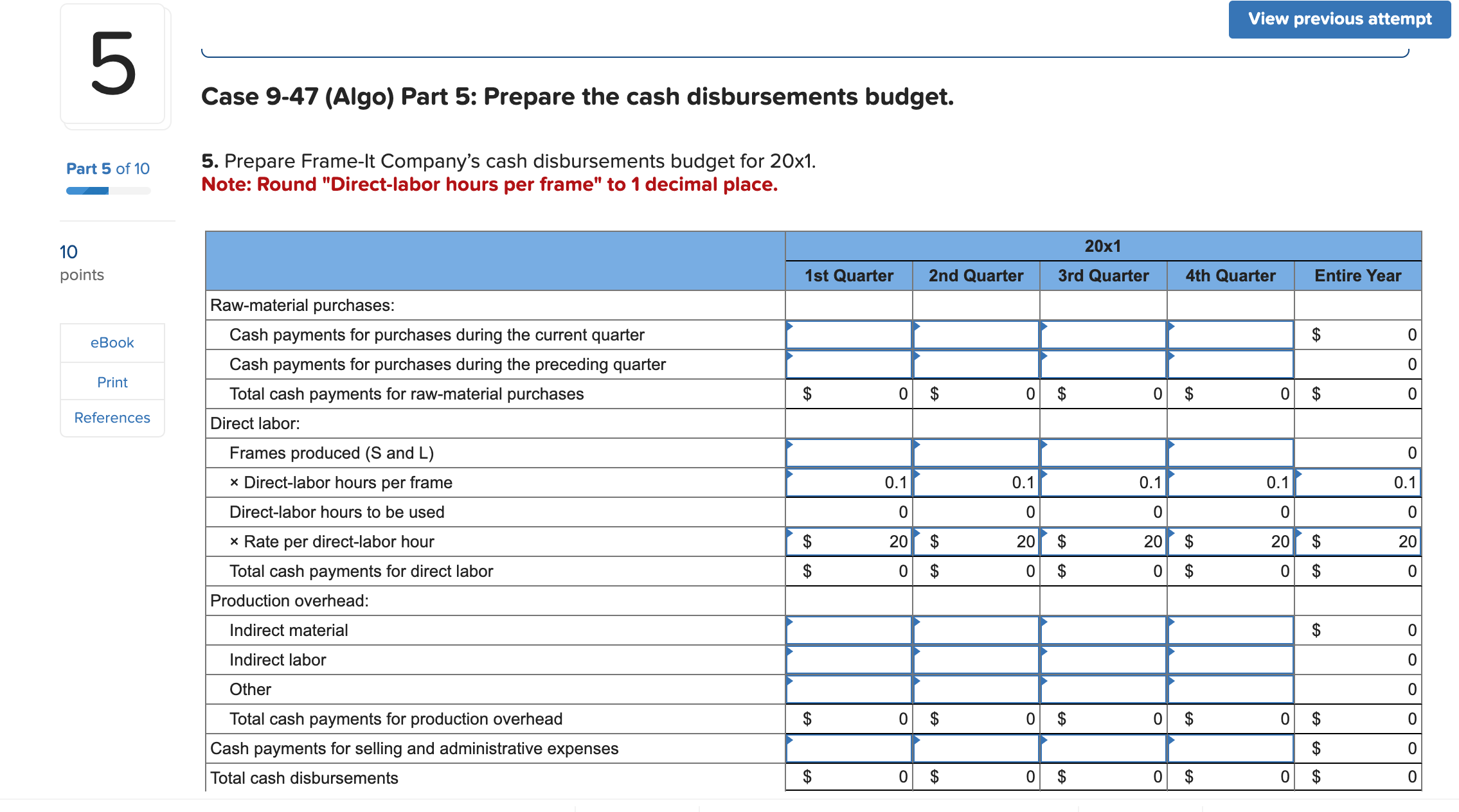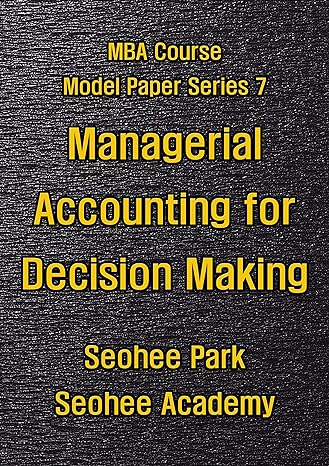Question
Jeffrey Vaughn, president of Frame-It Company, was just concluding a budget meeting with his senior staff. It was November of 20x0, and the group was
Jeffrey Vaughn, president of Frame-It Company, was just concluding a budget meeting with his senior staff. It was November of 20x0, and the group was discussing preparation of the firms master budget for 20x1. Ive decided to go ahead and purchase the industrial robot weve been talking about. Well make the acquisition on January 2 of next year, and I expect it will take most of the year to train the personnel and reorganize the production process to take full advantage of the new equipment.
In response to a question about financing the acquisition, Vaughn replied as follows: The robot will cost $1,140,000. Well finance it with a one-year $1,140,000 loan from Shark Bank and Trust Company. Ive negotiated a repayment schedule of four equal installments on the last day of each quarter. The interest rate will be 10 percent, and interest payments will be quarterly as well. With that the meeting broke up, and the budget process was on.
Frame-It Company is a manufacturer of metal picture frames. The firms two product lines are designated as S (small frames; 5 7 inches) and L (large frames; 8 10 inches). The primary raw materials are flexible metal strips and 9-inch by 24-inch glass sheets. Each S frame requires a 2-foot metal strip; an L frame requires a 3-foot strip. Allowing for normal breakage and scrap glass, Frame-It can get either four S frames or two L frames out of a glass sheet. Other raw materials, such as cardboard backing, are insignificant in cost and are treated as indirect materials. LaKendra Jackson, Frame-Its controller, is in charge of preparing the master budget for 20x1. She has gathered the following information:
- Sales in the fourth quarter of 20x0 are expected to be 80,000 S frames and 70,000 L frames. The sales manager predicts that over the next two years, sales in each product line will grow by 8,000 units each quarter over the previous quarter. For example, S frame sales in the first quarter of 20x1 are expected to be 88,000 units.
- Frame-Its sales history indicates that 60 percent of all sales are on credit, with the remainder of the sales in cash. The companys collection experience shows that 80 percent of the credit sales are collected during the quarter in which the sale is made, while the remaining 20 percent is collected in the following quarter. (For simplicity, assume the company is able to collect 100 percent of its accounts receivable.)
- The S frame sells for $10, and the L frame sells for $15. These prices are expected to hold constant throughout 20x1.
- Frame-Its production manager attempts to end each quarter with enough finished-goods inventory in each product line to cover 20 percent of the following quarters sales. Moreover, an attempt is made to end each quarter with 20 percent of the glass sheets needed for the following quarters production. Because metal strips are purchased locally, Frame-It buys them on a just-in-time basis; inventory is negligible.
- All of Frame-Its direct-material purchases are made on account, and 80 percent of each quarters purchases are paid in cash during the same quarter as the purchase. The other 20 percent is paid in the next quarter.
- Indirect materials are purchased as needed and paid for in cash. Work-in-process inventory is negligible.
- Projected production costs in 20x1 are as follows:
| S Frame | L Frame | |
|---|---|---|
| Direct material: | ||
| Metal strips: | ||
| S: 2 feet @ $1 per foot | $ 2 | |
| L: 3 feet @ $1 per foot | $ 3 | |
| Glass sheets: | ||
| S: sheet @ $12 per sheet | 3 | |
| L: sheet @ $12 per sheet | 6 | |
| Direct labor: | ||
| 0.1 hour @ $20 | 2 | 2 |
| Production overhead: | ||
| 0.1 direct-labor hour $10 per hour | 1 | 1 |
| Total production cost per unit | $ 8 | $ 12 |
- The predetermined overhead rate is $10 per direct-labor hour. The following production overhead costs are budgeted for 20x1.
| 1st Quarter | 2nd Quarter | 3rd Quarter | 4th Quarter | Entire Year | |
|---|---|---|---|---|---|
| Indirect material | $ 17,820 | $ 18,820 | $ 19,820 | $ 20,820 | $ 77,280 |
| Indirect labor | 82,130 | 86,130 | 90,130 | 94,130 | 352,520 |
| Other overhead | 51,250 | 56,250 | 61,250 | 66,250 | 235,000 |
| Depreciation | 27,000 | 27,000 | 27,000 | 27,000 | 108,000 |
| Total overhead | $ 178,200 | $ 188,200 | $ 198,200 | $ 208,200 | $ 772,800 |
All of these costs will be paid in cash during the quarter incurred except for the depreciation charges.
- Frame-Its quarterly selling and administrative expenses are $80,000, paid in cash.
- Jackson anticipates that dividends of $40,000 will be declared and paid in cash each quarter.
- Frame-Its projected balance sheet as of December 31, 20x0, follows:
| Cash | $ 102,000 |
|---|---|
| Accounts receivable | 139,000 |
| Inventory: | |
| Raw material | 149,280 |
| Finished goods | 328,000 |
| Plant and equipment (net of accumulated depreciation) | 8,700,000 |
| Total assets | $ 9,418,280 |
| Accounts payable | $ 130,360 |
| Common stock | 5,700,000 |
| Retained earnings | 3,587,920 |
| Total liabilities and stockholders equity | $ 9,418,280 |
Case 9-47 (Algo) Part 5: Prepare the cash disbursements budget.
5. Prepare Frame-It Companys cash disbursements budget for 20x1.
Note: Round "Direct-labor hours per frame" to 1 decimal place.

Case 9-47 (Algo) Part 5: Prepare the cash disbursements budget. 5. Prepare Frame-It Company's cash disbursements budget for 201. Note: Round "Direct-labor hours per frame" to 1 decimal place. Case 9-47 (Algo) Part 5: Prepare the cash disbursements budget. 5. Prepare Frame-It Company's cash disbursements budget for 201. Note: Round "Direct-labor hours per frame" to 1 decimal place
Step by Step Solution
There are 3 Steps involved in it
Step: 1

Get Instant Access to Expert-Tailored Solutions
See step-by-step solutions with expert insights and AI powered tools for academic success
Step: 2

Step: 3

Ace Your Homework with AI
Get the answers you need in no time with our AI-driven, step-by-step assistance
Get Started


